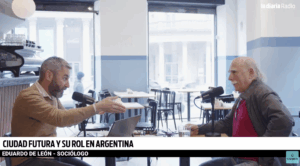Sociologist Eduardo de León is one of 23,000 subscribers to Uruguayan newspaper la diaria.
But he’s not just reading the publication, he’s also an active collaborator.
De León writes columns for la diaria and has been a guest for two episodes of reader-supported radio project "La Mañana de La Diaria," discussing policy issues on air with expert members of the community and host Martin Rodriguez.

Sociologist and la diaria subscriber Eduardo De León (right) as a guest on “La Mañana de La Diaria,” a program on laa diaria Radio presented by Martin Rodriguez (left).
"It seems to me that they're also filling a space there that didn't exist until now," De León told LatAm Journalism Review (LJR). "A space for debate and in-depth analysis of public policy."
De León is emblematic of the kind of journalism la diaria aims to produce: one that fosters a sense of belonging among readers while looking to them for knowledge.
Since its inception in 2006, la diaria has grown with the support of subscribers. Currently, 90% percent of its revenue comes from subscriptions like De León’s, according to la diaria editor Lucas Silva.
The publication also invites the community to fund specific products and initiatives. Recently, a documentary and radio station were born thanks to readers.
“The Facilitator,” a documentary entirely funded by 2,416 subscribers, premiered November 2024 and has over 450,000 views on YouTube. The film addressed two political scandals that occurred during the administration of former Uruguayan President Luis Lacalle Pou, related to the cases of former head of presidential security, Alejandro Astesiano, and drug trafficker Sebastián Marset.
De León said Uruguay needed investigative journalism that would encourage residents to confront the country's major dilemmas.
“There were people who only recently understood what happened when the documentary was released, who didn't follow [the scandal],” De León said. “We need to discuss this and resolve what we can. The country is built by the people. So, la diaria is building a voice right now, there, in those places. And I think that helps others do the same from other perspectives.”
Similarly, la diaria Radio, launched in May this year, is also supported by subscribers and was created to connect with readers through a traditional medium. The station is located in a cafe owned by the newspaper.
“It's like a search for transparency, for closeness, for conversation,” Damian Osta Mattos, la diaria’s manager, told LJR.
The aim of both projects is to build something new, unique and useful that the community would be interested in participating in and receiving.
“When you distribute news and have that connection, it can become like simply selling a service: people consume it, they pay you, you give the news…” Silva told LJR. “But you also have to show from time to time that there are other living people on the other side, who are eager to do new things.”
Silva said la diaria assesses needs and opportunities for new initiatives through surveys and a call center that seeks to attract new subscribers or encourage current ones to support other products the newspaper offers.
At one point, the team identified that its community listened to the radio, and the idea of listening to la diaria’s reporting emerged. However, before launching anything, the team consulted its community.
“A very important thing to be successful in what you're proposing is to identify at what point in people's routines what you're offering can fit,” Silva said. “Type of consumption, whether they think it's a good idea for la diaria to create a radio station, whether they'd be willing to support it.”

Title screen for the documentary "El Facilitador." Script by Pablo Stoll, investigation by Lucas Silva, produced by la diaria and funded by more than 2,000 subscribers. (Courtesy)
The la diaria team explained that its subscription model encourages co-creation with the community because that is the path that has guaranteed its independence from the beginning.
Osta said that Latin American journalism hasn't always been close to the people. Traditional advertising models focused on economic power and even the political class, but Osta said that media outlets that are going to survive need to practice "human journalism."
“It's not just about going out to ask people for support,” Osta said. “[It's] about trying to understand why someone would support the journalism you do, right? That's the first question you have to ask yourself, and you have to ask the people. The human journalism that will survive is the journalism that assumes knowledge resides in its community.”
Subscription manager Paula Falero shared many examples of collaborative synergy. For the radio station, one subscriber responded that she's a broadcaster and would like to be part of the project—she now narrates the audio. For the documentary, there were cases in which subscribers gave more than the proposed quota, or even offered something extra, such as one reader providing wine from her own vineyard for the documentary event.
“Everyone can participate in different ways,” Falero told LJR.
Along similar lines, Silva said the model itself requires them to think broadly and diversely: "20,000 people willing to pay in a country like ours forces you to have a broad range of offerings. You have to open many windows to let people in."
With the documentary, la diaria asked subscribers through surveys if they would be interested in supporting the project. At the same time, the newspaper's community management team contacted subscribers and told them about the importance of the initiative.
“I always say that the key to success, in our case, has been transforming journalism into a collective cause,” Osta said.
With radio, for example, De León, the subscriber and collaborator, expressed a sense of “collective adventure.”
“That atmosphere of a young company with a lot of people involved creates a lot of enthusiasm and excitement,” he said.
In that sense, for the creation of the documentary, la diaria sold "not only the desire to do this, but the need for someone to do it," Silva said.
According to a 2025 digital news report by the Reuters Institute, investigative journalism has been shown to foster public trust in the news. According to the report, there is a demand for journalism that investigates powerful people and delves into issues rather than "chasing algorithms for clicks."
“I think the connection and feeling like you're part of it is important, and that's what somehow differentiates you or makes people understand why they should pay a subscription,” Falero said.
De León expressed his appreciation for the growth of investigative journalism at la diaria since he started reading 12 years ago.
“Today you see a different product than it was 6-7 years ago,” he said. “They've achieved a very interesting balance between investigation, news analysis and opinion. And that's what I see as a consumer.”
Marisela Pérez Maita, from Maracay, Venezuela, is a journalism major at the University of Texas at Austin, expected to graduate in 2026 with a minor in social work. She has background in civic engagement and storytelling, having worked with the Center for Government and Civic Service at Austin Community College as a strategic planner and with The Daily Texan as a multimedia videographer. Beyond academics, Marisela enjoys reading James Baldwin, watching Japanese movies and exploring Austin parks and libraries.